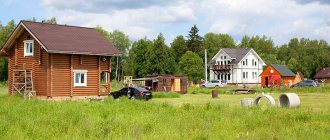The entire territory of the country is divided into separate land plots, each of which has its own type of permitted use and possible options for targeted exploitation.
Lands on which tourist facilities or recreational facilities can be organized are always in special demand, as they are potentially profitable real estate properties.
Such territories are called recreational lands. It is strictly forbidden to use them for purposes other than their intended purpose, for which hefty administrative fines are imposed.
These territories are regulated by a separate article of the Land Code and are under special protection and control by the state. The provisions of the Land Code clearly define what activities can be carried out on recreational lands and what cannot. We'll talk about this further.
Legislation
Land intended for recreational use is a major source of income for owners (regardless of whether it is a public or private organization). For users, these places are also of great importance, but not in financial terms. In any case, it is in the interests of both some and others to make the recreational area high-quality and safe. For this purpose, there are two articles in Russian legislation:
- Art. 98 of the Land Code of the Russian Federation (with accompanying comments) - regulates the composition and use of land. Namely:
- this type of property includes sports and recreational complexes, boarding houses, sanatoriums, parks, camps for children and other similar facilities;
- owners of recreational lands can transfer the opportunity to use them to other persons on the basis of the right of limited use of other people's lands - an easement.
- Art. 8 of the Code of Administrative Offenses of the Russian Federation provides for liability for the use of recreational areas other than those prescribed by law. The penalty for such an offense is a fine in the amount of one to five percent of the cadastral value of the site. But provided that the amount of penalty interest exceeds ten thousand rubles. In addition, for the lack of proper care of the lands and maintenance of buildings in a form suitable for use, a monetary penalty in the amount of twenty to four hundred thousand rubles is also provided, depending on who committed the offense: an individual or a legal entity.
It is important to know! Plots whose purpose is for recreational use and transferred to another person by right of easement cannot, by law, be seized from the original owner. The norm is regulated by the third paragraph of Article 98 of the Land Code.
Lease of forest areas for recreation
Lands in forest zones are subject to the norms of the “Forest Code of the Russian Federation” (LC RF), adopted on December 4, 2006 under No. 200-FZ. Article 41 of this document states that forest lands can be used for recreational activities and serve as a place of recreation for citizens.
Ownership of forest lands belongs to the state; they can be transferred for permanent (indefinite) use to regional authorities.
If forest areas are transferred to the jurisdiction of municipalities, then their rental by individual entrepreneurs or legal entities can only be carried out by registering rental rights with the municipality. To do this, you need to contact the land committee of the locality with an application and a list of services that are planned to be provided on such lands.
The submitted application is considered at public hearings, after which a decision is made on participation in the auction based on the provisions of Chapter 8 of the LC RF. After winning the lot, the participant is provided with an extract from the protocol.
What can you build?
If the lease right is granted, the development of a tourism business or the organization of a recreation area is allowed. Here you can build:
- sports base;
- camp permanent premises;
- holiday houses;
- hunting lodges;
- hotel complex or boarding house.
That is, the buildings are focused on the construction of recreational, physical education and health facilities, intended for recreation and sports, and sports and technical facilities. Act as forest infrastructure.
What is needed?
To erect buildings, the tenant must:
- draw up a forest development project (Part 1 of Article 88 of the RF LC);
- use the memory in accordance with the project;
- comply with the terms of the lease agreement for the land plot (forest plot);
- use the territory only in ways that prevent soil erosion and exclude (limit) harm to subsequent forest reproduction;
- comply with fire safety rules and sanitary safety rules;
- submit an annual forest declaration (Part 2 of Article 26 of the RF LC);
- submit a report on the use of forests (part 1 of article 49 of the RF LC);
- submit a report on the protection and protection of forests (Part 1 of Article 60 of the LKRF);
- comply with other legal requirements.
What can't be built?
You cannot build anything that is not included in the intended purpose, or that can damage the forest landscape or its ecology.
In particular, you cannot build:
- facilities for farming;
- industrial enterprises for processing wood, meat and animal skins;
- residential buildings and dachas.
Unauthorized deforestation and hunting are unacceptable. The tenant is obliged to reclaim lands used for construction, reconstruction and operation of facilities (Part 6, Article 21 of the RF LC), if their construction was not related to the development of forest infrastructure.
Cost and terms
Only land with an established cadastral value can be leased, since the cost of the first step of the auction is determined on its basis. Sometimes special calculations are used based on the income approach. In general, the assessment is guided by the norms of Articles 73 and 76 of the RF LC. The auction step cannot exceed 5% of the initially established cost.
As a result, the winning auction participant receives the right to lease. If it is the only one, the purchase of lease rights is allowed without holding a tender. The lease term cannot be less than 10 years. The maximum term is 49 years.
Possibility of redemption
Such a procedure is impossible, since forest lands cannot be transferred to private ownership. But sometimes exceptions are allowed when we are talking about lands that can be transferred to another category. For example, suburban forest areas, which can be converted into settlement lands. Or areas after fires and deforestation, if forest restoration is not planned for them.
It is required to act in accordance with the following step-by-step algorithm:
- Conduct a land examination confirming the possibility of changing the category. Get expert opinions.
- Write a reasoned request addressed to the Minister of the Ministry of Forestry, indicating detailed reasons for the transfer and parameters of the land plot, indicating the cadastral quarter.
- Attach examination reports, a notarized passport, extracts from the Unified State Register of Legal Entities and a copy of the constituent documentation, if this is a legal entity.
- At the discretion of the Ministry, the request is submitted to the authorities of the Government of the Russian Federation for consideration. Or the applicant is sent a reasoned refusal, with reference to the reason for the refusal.
The application must contain information that can provide the applicant with permission to purchase the property after transferring the land to another category.
The document contains the following information:
- reasons for ownerlessness;
- calculations of the cost of array restoration;
- project for the restoration of the land plot by the applicant;
- arguments for the effectiveness of such a translation.
Based on this document, a bill should be issued that allows for the removal of lands from this category, after which the registration of the massif can begin.
You can also find the following information on our website:
- Types of permitted land use.
- How to find out the category of land plot by cadastral number.
- Establishing the category of land plot.
- What is a land category code?
- What does it mean - the category of land has not been established?
- What is the penalty for inappropriate use of memory?
The concept of recreational land plots, their composition and legal regime
Land for recreational purposes is a certain territory, most often occupying part of forest or water bodies, intended for leisure and recreation of people. In general, the very word “recreation” implies some kind of restoration of performance. Their composition, as was written earlier, may include a wide range of objects intended for recreational needs.
It is important to know! Due to the fact that such facilities require the use of a large number of people, according to a number of legislative acts, owners must provide certificates from Sanitary and Epidemiological Stations and other organizations. Failure to comply with this rule is punishable by up to criminal penalties, that is, much more severe than for using the territory for other purposes.
It is worth paying special attention that not on all types of recreational lands it is enough to comply with Article 98 of the Land Code and have certificates from sanitary stations. There are land plots that are defined by law as:
- environmental protection zones;
- lands of cultural and historical heritage.
Categories of land and VRI
According to Art. 7 of the Land Code of the Russian Federation, all lands of our country are divided into 7 categories in accordance with their intended purpose . For each category of land, only its own types of permitted use can be applied.
For example, it is prohibited to build individual housing construction projects on forest lands or industrial territories. You can only build a private house on the territory of a residential area.
So, the following categories of land are distinguished:
- Settlements.
- Agricultural purposes.
- Forest Fund.
- Water Fund.
- Specially protected areas and objects.
- Reserve lands.
- Special purpose lands: industrial areas, sites for the construction of roads and highways.
Recreational land belongs to the category of specially protected areas and objects . Along with them, this category of lands also includes environmental, historical and cultural objects, especially valuable and unique areas.
The procedure for classifying these lands as specially protected areas and the procedure for their use are established by the Government of the Russian Federation on the basis of federal laws. At the local level, the order of land use is determined by orders of the regional or city administration.
Recreational lands must have unique ecological and landscape characteristics; there are no requirements for soil fertility.
Category, use, restrictions
Construction on recreational sites must strictly comply with their intended purpose - this is the main point of all laws governing this type of land. Article 98 clearly states that recreational land can be used on the basis of an easement. But for some reason, legislators did not clarify whether there is a difference between the use of public and private easements. Therefore, they are worth considering separately:
- Public. The most common type of organization of recreational areas. Anyone can use them, subject to certain rules (respect for nature, garbage collection and no fires.
- Private. The option is suitable for businessmen and entrepreneurs; the right to rest is provided for financial payment or work (tickets and vouchers are issued to workers of the enterprise, for example). Accordingly, the conditions of placement are regulated by the owner.
But in both the first and second options, the main thing is to be guided by all legislative norms, which, in addition to the Land Code, are also presented in the Forest and Water Codes (depending on the type of territory occupied, for example, a reservoir or the limits of spawning forest belts). The possibility (or lack thereof) of a person visiting a recreational site is called the legal regime. It can be regulated by both private owners and the state.
How are recreational lands used?
The legal regime of recreational lands is determined by the provisions of the Land Code of the Russian Federation. These territories can only be used for organizing recreation and health improvement for citizens. All interested citizens can use these lands for their intended purpose and the facilities located on them, subject to compliance with the regime of their operation.
Individuals, legal entities or individual entrepreneurs engaged in tourism or other similar business cannot apply for registration of recreational land as their own.
Educational and tourist trails and routes can be used by land users, landowners and tenants on the basis of an easement. When organizing an easement, land plots are not withdrawn from use.
An easement can be public or private . Public means the territory is accessible to everyone. Private easements are provided to companies for the construction of recreational or recreational facilities on the territories.
When constructing sanatoriums and other recreational facilities, it is possible to draw up a land lease agreement either by the founder of the legal entity or by a construction company acting as a developer of special-purpose facilities.
The state can withdraw land for its own needs from the property of citizens or companies if they meet the declared characteristics. This is land requisition, which can be carried out for up to 20 years.
We have figured out what can be built on recreational lands. These are all kinds of objects directly related to the intended purpose of the lands themselves. It remains to decide what to do on these lands is strictly prohibited.
What cannot be built on recreational lands?
No activity that does not correspond to the intended purpose is permitted in these recreation areas.
On recreational lands you cannot:
- build residential buildings;
- organize legal entities whose activities are not related to recreation and tourism;
- carry out unauthorized cutting of trees, bushes and grass;
- engage in poaching, illegal hunting or fishing;
- arrange landfills and dispose of waste;
- use land for agricultural needs;
- run a private farm.
For violating the intended use, the perpetrators face fines and confiscation of land, and for poaching - criminal liability.
Any work that would create a risk of harm to the health of others cannot be carried out on recreational land. All construction sites must be securely fenced and protected from people.
It is prohibited to carry out work on recreational lands that could test the soil surface and worsen its unique characteristics due to mechanical damage or the use of pesticides. It is prohibited to conduct any activity in these territories that could negatively affect the environmental condition of the objects.
Responsibility of the perpetrators
State land control and public control must monitor the use of recreational lands for their intended purpose . They can conduct inspections, issue orders, and submit case materials to the court.
Officials who used a plot of recreational land for other purposes are subject to a fine of 1-1.5% of the cadastral value of the plot.
All recreational sites must have a cadastral number and cadastral value . Without them, such a site simply could not have been put into operation.
According to the law, an administrative penalty from an official cannot be less than 20 thousand rubles. Legal entities for such actions will have to pay an administrative fine in the amount of 1.5-2% of the cadastral value of the land, but not less than 100 thousand rubles.
Guilty citizens who consider the actions of state land control to be illegal have the right to defend their rights through the courts.
Land classification, types of territories
What lands can be classified as cultural and historical heritage? By law it is:
- Objects that are on the list of historical buildings (century-old buildings, house museums of prominent personalities, etc.).
- Sights that are also on a special list in city planning departments (monuments, steles, eternal flame, etc.).
- National settlements that have preserved the life and culture of ancient times (handmade production, crafts, etc.).
- Mass and individual graves and other burials, both military and civilian.
Features of the use of recreational lands
Recreational lands are intended and used to provide sports, physical education and health activities for citizens, as well as to organize their recreation and tourism. This determines the scope of its operation.
To organize educational and tourist trails and routes, a special easement agreement may be concluded with the owner, user, possessor or tenant of the land. This allows you to lay routes through the territory without taking it out of use.
An easement is a limited right to use recreational areas and can be either public or private. Public means the territory is accessible to everyone. Private, as a rule, is provided to legal entities for the purpose of constructing holiday homes and similar facilities.
Carrying out recreational activities on forest lands is permitted in accordance with the provisions of Art. 41 (hereinafter referred to as the LC RF). The legislator also provided for the possibility of erecting special temporary buildings in the forest. In this case, the territory is provided to state and municipal institutions for permanent (indefinite) use.
For legal entities, it is possible to lease forest lands for recreation (clause 4 of article 41 of the LC RF). Please note that this category of land is not provided to individuals.
Features of the purchase and sale and rental of plots
Of course, recreational lands, especially if they are also carriers of cultural heritage objects, are subject to a number of restrictions in terms of drawing up purchase and sale transactions. If the property is private and not built in an environmental or cultural-historical zone, then there should be no problems with the sale of the property. Unless the buyer must, in addition to all formalities, obtain permission for such activities. But otherwise, the buyer (and partly the seller) will have to collect a whole package of necessary documents and certificates:
- confirmation of the environmental safety of future buildings (especially for industry);
- absence of causing architectural or any other damage to cultural values (it’s unlikely that anyone will allow the construction of a modern leisure center next to an 18th-century mansion);
- strict delineation of area.
Each point includes constant consultations with specialists and strict adherence to all legal regulations (which will require a considerable investment of money and time).
The concept of recreational lands
The definition of the term can be found in paragraph 1 of Art. 98 Land Code of the Russian Federation. The legislator indicates that lands within recreational zones are areas used for recreation, tourism, physical education, health and sports activities of citizens.
Not every area is suitable for these purposes, although each territory has resources that can be used to meet the needs of the population. Only the lands of settlements that have recreational potential should be adapted for recreation and recreation.
The potential is assessed based on natural, environmental, sanatorium-resort (balneological, mud) and cultural-historical prerequisites. They create the necessary conditions and climate to restore the well-being and performance of people tired of the bustle of the city.
Recreation of a land plot is the existing and created favorable characteristics of the territory for the restoration of human health.
Who is provided and what can be built on recreational lands
These lands are provided to private individuals and legal entities who wish to organize an area for recreation of people (both a certain circle and everyone). Of course, the main goal of this type of activity is to make a profit; recently, the demand for such leisure facilities has increased in society and includes a number of facilities:
- sports centers (recreational centers, sites for certain sports, swimming pools, fitness rooms, etc.), they rarely require special permits (excluding swimming pools);
- tourist facilities (health paths, health trails, springs) must be designed in accordance with medical standards;
- buildings intended for inactive recreation (cinemas, concert halls, etc.).
In addition, it is allowed to build industrial structures to service leisure centers (except for the cases discussed in the previous section). And also the owners have the right to expand their holdings (similarly, without violating the legal norms listed above).
What is prohibited?
In addition to the fact that such lands can only be used in accordance with a certain legal regime, no activity that does not correspond to the intended use is allowed here. The implementation of this provision is supervised by state bodies and municipalities. According to the law, on such lands it is prohibited :
- erect residential buildings;
- organize enterprises and companies not related to the recreation of citizens;
- carry out unauthorized cutting of grass, cutting down trees and shrubs;
- engage in poaching;
- use for agricultural needs or subsidiary farming;
- arrange landfills.
For non-compliance with the norms for the use of plots, administrative liability is provided, allowing for fines and seizure of land. Poaching is a criminal offense.
Since recreational areas are places of large gatherings of people, any activity that entails a risk of harm to health is unacceptable here. If construction of facilities is carried out here, then the zone should be ensured by restricting access for vacationers, especially children. The issue of citizen safety should be a priority. No negligence or irresponsibility is allowed on these lands.
In addition to the above, it is unacceptable to carry out types of work that can damage the soil surface, changing its unique properties as a result of poisoning with pesticides or mechanical damage. And also carry out activities that violate the environment in the recreation area. This also applies to rights holders of adjacent land plots belonging to other categories of land.
Prohibition on using land for other purposes
Russian legislation provides for a number of prohibited norms regarding the use of recreational land not for the purpose of organizing recreation for citizens. In addition, transferring land from one category of plots to another is also prohibited. Punishments for these violations are provided for in the Code of Administrative Offenses of the Russian Federation. But how can lands be used for purposes other than their intended purpose? The following violations exist:
- violation of sanitary standards of Rospotrebnadzor and other organizations (this especially applies to recreational facilities related to food production);
- transformation of leisure centers and tourist facilities into any other organizations (the site cannot become a different category and must belong only to a certain land group);
- environmental damage caused by industrial structures, environmental pollution;
- lack of organization for the safety of vacationers, inadequate equipment of facilities.
Legal regime and use of lands with recreational status
The legal regime of recreational lands is determined by the current land legislation. Since the main purpose of lands of this category is to satisfy citizens in health improvement and cultural and sports recreation, the lands should be used exclusively for these purposes.
Thus, it is not prohibited for a legal entity to rent or acquire ownership of land with the permission of state or municipal authorities, and then carry out activities on it related to the organization of recreation for citizens. For example, for the construction of a recreation center, children's camp, educational building, tent camp or any other type of buildings and structures of recreational significance.
It is prohibited to give ownership of plots of land allocated for recreational purposes to private individuals, in accordance with the norms of the current legislation.
However, if such lands intersect with land plots where the owners are individuals, legal entities, state authorities or a municipality, then the rules of easement, both private and public, are imposed on the property of these persons. This, in turn, does not entail loss of ownership of the site.
Areas that have the status of recreational land can be used only for their intended purpose - to organize recreation for citizens. Moreover, if a suitable plot of land is owned by individuals or legal entities, then it can be forcibly seized by the state to fulfill its needs or requisitioned.
Requisition of land plots of recreational value can be carried out for a period of two to twenty years.
Important points
- Where can the recreational area be located? The site is located within a city, village or any other entity, but outside residential settlements. This measure is reflected in a number of legislative acts, namely in the eighteenth chapter of the Land Code. Perhaps because of this, attendance at recreational facilities will decrease, but the safety of vacationers and the quiet activities of citizens living nearby will be ensured.
- Do local governments or representatives of the federal center have the right to take away part of recreational lands for use? Due to the fact that this type of territory is regulated by special land use rules, a number of restrictions may be imposed on the owner, including from any government authorities. But, in accordance with the Land Code, representatives must formalize the right of limited use - a public easement - the application of which is regulated by the twenty-third article of the Land Code of the Russian Federation. In addition, users (in this case, the authorities) are obliged to carry out environmental protection work and prevent damage to leisure facilities. If these obligations are violated, the owner may demand monetary compensation in court.
https://youtube.com/watch?v=Fm81psfSxMM
To summarize, the use of recreational lands requires careful attention to the norms of the Land Code and related codes. Activities related to the organization of recreation directly affect the interests, health (and sometimes even the lives) of many citizens, so it is important to comply with the laws and competently plan all construction work, without skimping on lawyers and other specialists.
Privatization of recreational lands
Privatization of a land plot in a recreational zone is theoretically not prohibited, as can be concluded by referring to the provisions of the Land Code.
According to Art. 28 of the Land Code of the Russian Federation, a refusal to grant ownership of land can be received by a citizen if the land plots are withdrawn from circulation or a decision to ban privatization is accepted in relation to them.
Those lands that are in state or municipal ownership, within specially protected natural areas, are limited in circulation.
For areas located in a recreational zone, restrictions are established only on types of economic activity . There is no ban on privatization in the law. Consequently, such lands can be privatized if desired and all conditions are met.
In this case, the administration’s refusal to privatize must be challenged in court.
Legal regime
The lands in question have a specific legal status. They are used for recreational purposes without seizure from owners or temporary managers. However, the rights of the latter are burdened: their allotment can be free for everyone to access. Everyone has the right to visit such a site if they comply with the rules of use.
The value of recreational lands is evidenced by the fact that their misuse or transfer to another group of sites is strictly prohibited. In addition, if an individual or legal entity has ownership rights to a site with recreational potential, the state can forcibly seize the land for state or municipal needs.
However, such plots are not excluded from circulation. Recreational land ownership can be transferred to legal entities, subject to the consent of municipal and government agencies.
What is a recreational zone
A tourist and recreational zone (TRZ) is a special type of economic zone where the state and residents create favorable conditions for the development of tourism and mass recreation of the population. Among the main goals of organizing such zones are the following:
- promoting the development of tourism activities in a particular region;
- increasing the competitiveness of the tourism business;
- development of health resorts;
- increasing the level of prevention and treatment of various diseases.
In tourist and recreational areas, deposits of mineral waters and various natural resources with medicinal properties, which also include healing mud, often begin to be developed.
What are the advantages of organizing such zones? Globally, this contributes to the fact that investments are beginning to be attracted to the country and a new competitive product is appearing. What is also important is that ordinary holidays and travel are moving to a higher level.
In addition, the creation of recreational zones increases the population of a certain area, since new specialists in different fields are attracted here.
Recreational lands
Recreational lands include lands intended and used for organizing tourism, physical education, health and sports activities of citizens.
Recreational lands include land plots on which there are holiday homes, boarding houses, campsites, physical education and sports facilities, tourist centers, stationary and tent tourist and recreational camps.
fisherman's and hunter's houses, children's tourist stations, tourist parks and forest parks, educational and tourist trails, trails and sports camps, and other similar objects.
The Land Code of the Russian Federation correctly reflects the concept of “recreational land”, since recreation is rest, recuperation after work. At the same time, the law does not specify the legal regime of lands used for the placement of permanent and seasonal recreational facilities; holiday homes, boarding houses, campsites, tourist centers, fisherman's and hunter's houses, etc.
The use of educational and tourist trails and routes can be carried out in accordance with the law on the basis of easements, while the specified land plots from the right holders are not withdrawn from use.
Easements, as is known, can be public or private. For recreational needs, on the basis of an easement, it is possible, in particular, to use land plots of forest and water funds. Thus, the Forest Code of the Russian Federation allows citizens to freely stay in the forest fund and in forests not included in the forest fund, unless otherwise provided by the legislation of the Russian Federation (public forest easement). In addition, the use of forest areas for cultural, recreational, tourist and sports purposes is directly considered by the Forest Code of the Russian Federation as one of the types of forest use.
To locate stationary recreational facilities on forest fund lands, the rights to use forest fund plots and the right to use forest plots not included in the forest fund arise on the basis of a lease agreement for forest fund plots, an agreement for the gratuitous use of a forest fund plot, as well as a logging ticket, warrant or forest ticket.
Water bodies can be used for recreational purposes (Article 50 of the Water Code of the Russian Federation). They can be used for mass recreation, tourism, and sports in places that are established by local governments in agreement with specially authorized state bodies for managing the use and protection of water resources.
The Land Code of the Russian Federation also includes lands of suburban green zones as recreational lands, which is quite justified. This is their legal and natural essence. The territory of the suburban zone of the city includes, as stated in the Urban Planning Code of the Russian Federation, lands adjacent to the border (line) of the city and intended for the development of the territory of this city. In the suburban areas of cities, green areas are allocated. They perform sanitary, hygiene and recreational functions.
They prohibit economic and other activities that have a harmful impact on the environment.
In addition to the above, the Town Planning Code of the Russian Federation provides for the allocation of recreational zones on the territory of settlements. Recreational zones of cities and settlements are intended to organize recreational areas for the population and include parks, gardens, urban forests, forest parks, beaches, and other facilities. Recreational zones may include specially protected natural areas and natural sites. On the territory of recreational zones of settlements, the construction and expansion of existing industrial, municipal and warehouse facilities that are not directly related to the operation of health and recreational facilities are not allowed.
Historical and cultural lands are one of the types of specially protected areas. The Land Code of the Russian Federation includes the following lands (Article 99):
- objects of cultural heritage of the peoples of the Russian Federation (historical and cultural monuments, including objects of archaeological heritage);
- places of interest, including places of historical trades, industries and crafts;
- military and civil burials.
This list of historical and cultural objects should be considered basic, but not exhaustive.
The Land Code establishes strict requirements for the use of said lands for their intended purpose. Land plots recognized as historical and cultural value are not confiscated from the rights holders, but on certain lands of historical and cultural significance, including lands of cultural heritage sites subject to research and conservation, any economic activity may be prohibited.
In order to preserve the historical, landscape and urban environment, protection zones for cultural heritage sites are established in accordance with federal laws and the laws of the constituent entities of the Russian Federation. Such zones can be established within settlements and outside them.
We recommend: Controversial issues regarding land plots
Settlement territories, in accordance with current legislation, are zoned according to their economic and urban planning purposes. In territorial zones, subzones can be distinguished, the features of the use of territories are determined by urban planning regulations, taking into account the restrictions on their use established by land legislation and the legislation of the Russian Federation on the protection of historical and cultural monuments.
Monuments of history and culture are buildings, memorial places and objects associated with historical events in the life of the people, the development of society and the state, works of material and spiritual creativity that are of historical, scientific, artistic or other cultural value.
Enterprises, institutions, organizations and citizens are obliged to ensure the safety of historical and cultural monuments located on the lands provided to them for use, and to comply with the rules for their protection, use, accounting and restoration. They are responsible for their safety.
In order to ensure the protection of historical monuments, archeology, urban planning and architecture, and monumental art, security zones are established. Within the protected zones, excavation, construction and other work is prohibited without the appropriate permission from the monument protection authorities.
Certain areas of cities and other settlements that have special historical, scientific, artistic and other cultural value, as well as memorial sites associated with historical events, may be declared protected areas.
Within the lands of historical and cultural significance outside the lands of settlements, a special legal regime for the use of lands is introduced, prohibiting activities incompatible with the main purpose of these lands. The use of land plots not classified as historical and cultural lands and located in these zones is determined by the rules of land use and development in accordance with the requirements for the protection of historical and cultural monuments (clause 4 of Article 99 3K of the Russian Federation).
According to the Law of the RSFSR “On Subsoil”, rare geological outcrops, mineralogical formations, paleontological objects and other subsoil areas of special scientific and cultural value can be declared in the prescribed manner as geological reserves, wildlife sanctuaries, natural or cultural monuments. Any activity that violates the safety of these reserves, wildlife sanctuaries and monuments is prohibited (Article 33).
The bodies of state geological control are entrusted with control over the protection of subsoil areas of special scientific and cultural value, over compliance with the conditions of maintenance of natural geological reserves, stratotype and reference sections, individual geological natural monuments, unique accumulations of fossil fauna and flora (Regulations on state control over geological study, rational use and protection of subsoil, approved by Decree of the Government of the Russian Federation of May 12, 2005 No. 293)
Objects of historical and cultural heritage within the territories of traditional environmental management of indigenous peoples of the Russian Federation: ancient settlements, other historical and cultural monuments, religious buildings, burial places of ancestors and other objects of historical value can be used only in accordance with their purpose. Scientific or other research in relation to objects of historical and cultural heritage within the boundaries of territories of traditional nature management is carried out if the specified activity does not violate the legal regime of territories of traditional nature management (Article 16 of the Federal Law “On the territories of traditional nature management of indigenous peoples of the North, Siberia and the Far East of the Russian Federation”). Federation").
Concept and purpose
Articles of “land” laws clearly classify all territories according to their existing and/or potential purpose and use. Some territories are classified as specially protected. Chapter 18 is devoted to this.
The lands we are considering are discussed in Article 98. Recreational lands are intended and used to create opportunities for tourism, sports, as well as relaxation and health improvement for everyone (those in need). Also, Article 98 stipulates the composition of recreational lands, as well as everything that can be built there.
What territories are included?
Recreational lands are heterogeneous. They vary depending on the specific use.
According to paragraph 2 of Art. 98 of the Land Code of the Russian Federation, this category includes areas with:
- camping;
- holiday homes, boarding houses;
- objects of physical culture and sports;
- tourist centers;
- stationary and tent tourist and recreational camps;
- children's tourist stations;
- parks;
- educational and tourist trails and routes;
- children's and sports camps, and other similar facilities.
Read more: Reasoned refusal to hire sample
Such lands include forest belts, parks, as well as public gardens located outside the city or within the city limits.











